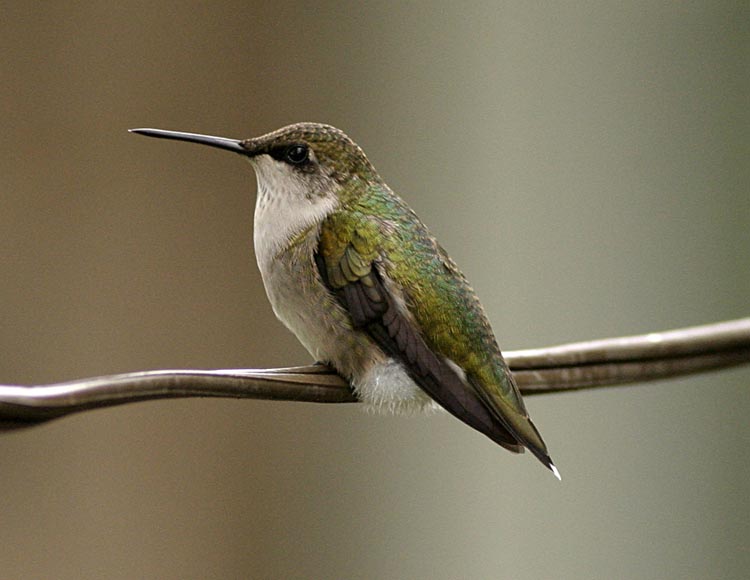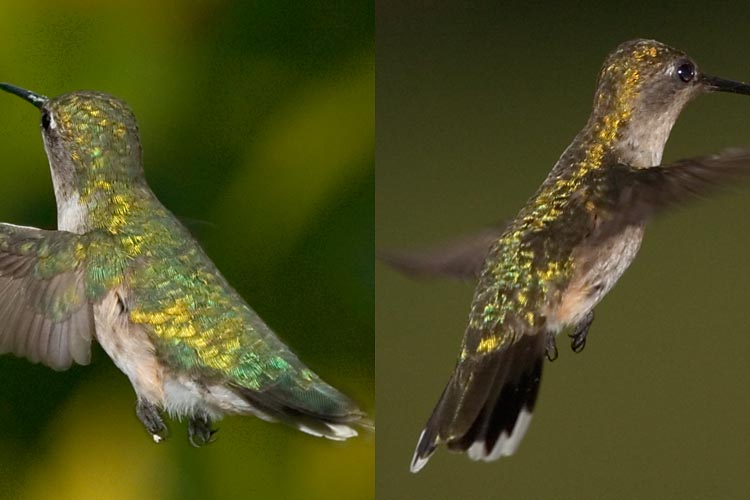HUMMINGBIRD COLOR
Hummingbirds aren't the color that they appear to be. That is, their feathers contain a
pigment that is one dull color.
The pigment is melanin. The colors that you see, such as
blues, greens and reds are a result
of several things including: 1) diffraction of light due to the regular
spacing of the particles of melanin, interrupting certain
colors; and 2) absorption of the remaining colors by the
pigment. For a far more detailed and accurate description of
this phenomenon, read this
document and this
document. The explanation of how color is produced by
a hummingbird's feathers also explains why you can only see
the red in a ruby throated hummingbird's gorget when it is lit
and viewed from certain angles. Some colors can be seen from
wider angles than others. Feathers that
aren't illuminated from the correct angle will appear
colorless.
This explanation for the hummingbird's color should guide
you in your decisions on how to illuminate the hummingbirds
that you photograph. It should also dispel some of the notions about
natural light versus flash and diffused versus "bare
bulb" flash or either of these methods showing more or
less color.
"Iridescence"
Some photographers suggest that point source lighting, like
that from flash units with no diffusers (like umbrellas,
reflectors and soft boxes), shows the "iridescence"
of the birds. This may be true. People mean different things
when they use the word "iridescence." However, all
hummingbird color (other than gray) is
iridescent. So if you capture green, blue, gold or red in your
photo then your photo has captured that iridescence. If what
you are talking about is the change in color when the angle of
view or lighting is changed, no static photograph can show
this.
What some refer to as iridescence in hummingbird
photographs is really specular highlights. That is,
reflections of the light source from the bird that contain
nearly all the spectrum produced by the light source. I.e,
bright reflections with little color. I mean this in reference
to comments about iridescence from particular light sources
because, I repeat, all hummingbird color is iridescent.
Does this mean that specular highlights are bad. No. Its
simply a matter of preference. Personally, I prefer uniform, saturated
color on a hummingbird. This doesn't mean I want the bird to
only be one color, but I want the colors to be smoothly
illuminated without small bright spots produced by my flash or
any other point light source. Take the following image as an
example:

Illumination from two (2) dedicated E-TTL
flash units with white umbrellas
All the color is there. The only areas with no color are
feathers that produce little or no color and a small area of
dark gray on the very back of the bird. I did manage to get
one "hot" feather at the edge of the gorget, but
even so, the result is simply altered color without a
distracting bright spot.
The following image is also very evenly illuminated:

Illumination produced by a cloudy sky
In the above image, you will notice even
coloration marred only by a little glare. The glare is
provided by that portion of the light source beyond the bird
that is being reflected at oblique angles toward to camera.
This is a problem not encountered when flashes are stationed
on the same side of the bird as the photographer. Then again,
hummingbirds don't always cooperate by perching near your
flash heads.
Okay, now you have seen even illumination. How
about some of those specular highlights:

Same Location, same conditions, add
on-camera flash.
The above photo show what happens when your
primary source of lighting changes from an overcast sky to
your on-camera, hot shoe flash. Ambient light is still playing
enough of a role in the above photo to give color to feathers
not golden with light from the flash, but for all the
non-initiated would know, this is a different species.
The following side-by-side images show the
difference between on-camera, hot-shoe flash and off-camera,
diffused flash:

Two diffused flashes on the left, one bare
bulb flash on the right
The above image is not a perfect comparison,
but you should be able to see the difference. On the right are
the reflective highlights from a single point source, a bare
bulb flash mounted on the camera. On the left is a bird
illuminated by two flashes with diffusers (an umbrella and a
9"x9" soft box). Notice the areas of gray on the
bird on the right. The bird on the left, being illuminated
from a larger area or larger angle has much more of his
feathers showing color. Both images were taken by the same
camera, using the same lens with the same amount of saturation
and sharpening done. In fact, only the levels were adjusted in
Photoshop before the images were combined into one.
One factor in producing specular highlights is
the proportion of light that is supplied by point sources. In
shade in midday in the summer, there will still be plenty of
light from directions other than the flash to give color to
the feathers that aren't positioned to produce color from the
light supplied by the flash. However, if you increase flash
output and decrease ISO and/or close your aperture your image
will start to look more like the one on the right. The same
will be true early or late in the day when the ambient light
wanes.
Another factor is the angle of the light
source in relation to the camera. Specular highlights seem to
increase when the flash is near the taking lens, just as
red-eye increases in snapshots of people when the flash is
near the lens, though probably the result of a different
effect.
The smaller the angle of the
light source, i.e., the further you place the flash from the
bird, the more pronounced the highlights will be, though this
tends to level out after the flash is two meters or so from
the bird. So if you want the bright highlights, put powerful
flashes about 6 feet or so from your subject and keep the
flash units fairly close to the camera, or close to the direct
line from the lens to the bird.
The opposite of point sources is what you want
if you want your colors to look more uniform. You want a wide
area light source. With flash units, that means umbrellas,
reflectors or soft boxes. It may be possible to help out the
sun with reflectors and other methods used by fashion
photographers, but I have never tried this and do not know if
this would discourage the birds from feeding near the
reflectors.
|

